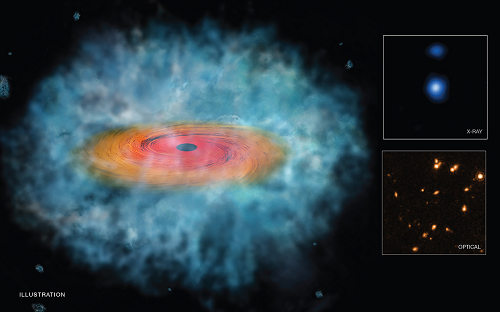NASA Telescopes Find Clues for How Giant Black Holes Formed So Quickly
Using data from NASA's three Great Observatories, astronomers have found the best evidence yet of a mechanism that produced supermassive black holes in the early universe. If confirmed, this result could lead to new insight into how black holes were formed and grew billions of years ago.

This artist's illustration depicts a possible "seed" for the formation of a supermassive black hole, an object that contains millions or even billions of times the mass of the sun. In the artist's illustration, the gas cloud is shown as the wispy blue material, while the orange and red disk is showing material being funneled toward the growing black hole through its gravitational pull.
Researchers found evidence that two objects could have formed in this way, by directly collapsing into a black hole from a large cloud of gas. These two "direct-collapse black hole" candidates are so distant that they may have formed less than one billion years after the big bang.
The inset boxes show data from the Chandra X-ray Observatory (top) and Hubble Space Telescope (bottom) of one of the objects described above. The Hubble image shows the faint, distant galaxy at the center of the image, and the Chandra image shows X-ray emission from material falling into the black hole in the same galaxy.
The researchers used computer models of black hole seeds combined with a new method to select candidates for these objects from long-exposure images from Chandra, Hubble, and the Spitzer Space Telescope (not shown in this graphic). By analyzing the combined light from the three telescopes, the team was able to search through thousands of objects to look for any that had properties that matched those predicted by their models.
Two candidates emerged that had the expected red color, seen by Hubble and Spitzer, as well as the X-ray profile predicted from Chandra. These objects were found in the Cosmic Assembly Near-infrared Deep Extragalactic Legacy Survey and the Great Observatories Origins Deep Survey-South surveys. The next steps will involve getting more data on these two intriguing objects as well as extending the analysis to other surveys to look for more direct-collapse black hole candidates.
NASA's Marshall Space Flight Center in Huntsville, Alabama, manages the Chandra program for NASA's Science Mission Directorate in Washington. The Smithsonian Astrophysical Observatory in Cambridge, Massachusetts, controls Chandra's science and flight operations.
NASA's Jet Propulsion Laboratory in Pasadena, California, manages the Spitzer Space Telescope mission for NASA's Science Mission Directorate in Washington, D.C. Science operations are conducted at the Spitzer Science Center at the California Institute of Technology in Pasadena. Spacecraft operations are based at Lockheed Martin Space Systems Company in Littleton, Colorado. Data are archived at the Infrared Science Archive housed at the Infrared Processing and Analysis Center at Caltech. Caltech manages JPL for NASA.
Source: HubbleSite
- 333 reads
Human Rights
Fostering a More Humane World: The 28th Eurasian Economic Summi

Conscience, Hope, and Action: Keys to Global Peace and Sustainability

Ringing FOWPAL’s Peace Bell for the World:Nobel Peace Prize Laureates’ Visions and Actions

Protecting the World’s Cultural Diversity for a Sustainable Future

Puppet Show I International Friendship Day 2020

